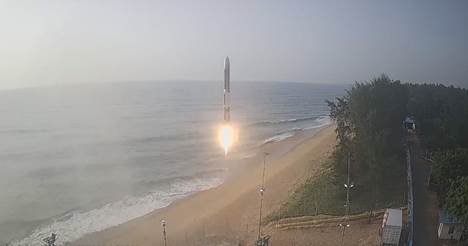India’s Low-Cost Space Missions Boosted by DST-Supported Combustion Research
An innovative two-stage orbital launch vehicle called Agnibaan powered by India’s first patented Single-Piece 3D-printed Semi-Cryogenic Engines developed and incubated at IIT Madras was launched on 30th May 2024, marking a significant milestone for the country’s space ecosystem.
The state-of-the-art launch vehicle paves the way for more frequent missions for India and also for making the country a commercial hub in the space sector.
The Launch Vehicle has been developed by Agnikul, a startup in space-tech. Agnikul is incubated at Incubation Cell, IIT Madras [a TBI supported by Department of Science and Technology (DST)] and has been showcased in startup expo during DST‘s Startup Utsav during August 2022. The startup works out of the National Centre for Combustion Research and Development (NCCRD) at IIT Madras which is supported by the Department of Science and Technology (DST).
NCCRD supported by DST develops state-of-the-art capabilities in combustion research. It is world’s largest combustion research centre working on automotive, thermal power and aerospace propulsion, fire research and microgravity combustion. Apart from academic research and training, NCCRD works closely with industrial and R&D organizations.
Working out of NCCRD, the Chennai-based startup has developed a range of technologies that can improve the reliability of space engines and speed up their manufacturing, making it easier to organize space missions. The startup has successfully launched its first inaugural mission – Agnibaan SOrTeD. Agnibaan SOrTeD (Agnibaan Sub-Orbital Technology Demonstrator) is a single-stage vehicle propelled by a single semi-cryogenic pressure-fed engine which has been used for Agnibaan. This endeavour took place from India’s first private launchpad at SDSC SHAR.
NCCRD supported by DST has been the training ground for Agnikul, where they learnt the intricacies of building a rocket and this helped the startup figure out the technology in the initial phases. Another Technology Innovation Hub (TIH) funded by DST, Pravartak Technologies from IIT Madras became their partners for developing and commercializing technologies for Space and Deep Space.
The Government’s opening up of the space market for private players provided an opportunity in the sector. They used the technologies they had develpped to start a manufacturing the engines at the company’s additive manufacturing facility at IIT Madras Research Park, popularly called the Agnikul Rocket Factory – 01 which was inaugurated in 2022.
Agnikul’s groundbreaking achievement is the engine which assembles the individual components, a feature that makes it unique. It is manufactured with high-grade aerospace materials making it more reliable. This also reduces the realization time and facilitates faster manufacturing as compared to traditionally manufactured engines.
The DST’s TBI supported startup established India’s first private launchpad along with a Mission Control Centre .at Sriharikota range. The plan, the design, and the execution of construction of the launchpad are completely done in-house.
Apart from this, the autopilot software developed by the company ensures that the vehicle remains on the mission path despite all the externalities, which is critical for any mission.
The launch vehicle, Agnibaan is India’s first launch vehicle to feed propellants through a powerful and compact electric drive. The inhouse developed High-speed motor controller can deliver high power at high frequency and the noise generated by switching high voltages is mitigated by proper shielding and earthing.
The bunch of technologies including the World’s first single-piece 3D printed engine, and configurable vehicle makes the launch cost the same across the spectrum of payload mass – 30 kg to 300 kg.
Launch of Agnibaan SorTeD by the DST -TBI supported startup helped achieve the world’s first flight with a single-piece patented rocket engine, India’s first semi-cryogenic engine flight, first flight with Ethernet-based avionics architecture, and stands as the first controlled ascent flight from India.

